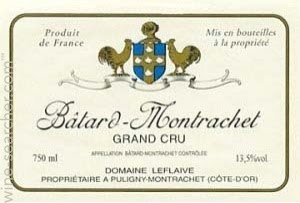
2011 Domaine Leflaive Offering
2011 Domaine Leflaive Offering
| Founded in 1717, Domaine Leflaive has long been one of the most highly regarded white wine producers in Burgundy. During its respectable history, the domaine has acquired parcels in four of the five Montrachet grand crus and four of the best premier crus. Under the stewardship of Anne-Claude Leflaive, the domaine converted entirely to biodynamic farming practices in the 1990s.Distinguishing Domaine Leflaive beyond the impeccable pedigree of its vineyard sites and biodynamic practices, are the skill and care of its winemaking. The combination of these efforts has produced remarkable results, further elevating the standard for one of the world’s greatest wines. |
Pure Burgundian OfferingsThe Leflaive family can trace its roots in Burgundy back more than 400 years, when Marc Le Flayve lived in Cissey, not far from Beaune. Nearly two centuries later, his descendent, Claude Leflaive took up residence in Puligny and married a girl from the village in 1717. After establishing the family’s domaine, Claude became one of the first vignerons on record in Puligny. The 20th-Century VigneronOver the next 200 years, the family’s land was divided between each new generation due to French inheritance laws. Among those to receive a parcel was Joseph Leflaive, who inherited the family domaine and a mere 2 hectares (5 acres) of vines in 1905. He was a brilliant student and, at the age of 20 became a maritime engineer, later taking part in the construction of the first French submarine. Despite his maritime career, Joseph retained strong ties to his family domaine and over the years gradually built up its vineyard holdings. In the aftermath of the phylloxera and oïdium epidemics of the late 19th century, numerous vineyard owners began selling their land. This was a golden opportunity for Joseph, who acquired parcels in exceptional climats: Le Chevalier, Le Bâtard, Les Bienvenues, Les Pucelles and Le Clavoillon. By 1926, he had increased the domaine’s holdings to 20 hectares (50 acres). He then returned to Puligny to oversee the estate. Working with his respected friend and steward, François Virot, Joseph systematically replanted his land with Chardonnay. The Next GenerationDescribed by Clive Coates in his 1997 book, “Côte d’Or,” Vincent was a “doyen of Puligny and a man of great charm, wit, hospitality and winemaking genius.” He earned this praise when he and his brother Joseph (Jo) took over the family domaine after their father’s death in 1953. It was Vincent who acquired a tiny parcel of Le Montrachet in 1991, which was only large enough to fill a single 500-liter (132-gallon) cask. The domaine now has parcels in four of the five Montrachet grand crus and four of the best premier crus, including a large portion of Clavoillon, for a total of 23 hectares (57 acres). Innovator and Meticulous ConservatorIn 1990, Vincent’s daughter, Anne-Claude Leflaive, and Jo’s son, Olivier, became co-directors of the domaine. Olivier has since concentrated on his négociant business, and, after her father’s death in 1993, Anne-Claude has assumed the sole responsibilities of the domaine. The ascendancy of a new generation at Domaine Leflaive brought a spirit of re-evaluation and experimentation, particularly in regard to vineyard management. Anne-Claude immediately took a passionate interest in the long-term health of the vineyards, and to that end began biodynamic treatment of 1 hectare (2.5 acres) of vineyards in 1990. By 1997, Domaine Leflaive was farmed entirely according to biodynamic principles. Anne-Claude’s passion and her dedication are evident in every aspect of the domaine, from her respect for the soil to her commitment to quality throughout the winemaking process. She has thoroughly maintained her family’s pioneering spirit while demonstrating great prescience in her full adoption of biodynamic viticulture. Her progressive nature has firmly cemented Domaine Leflaive as a benchmark for all Burgundy producers. |
The 2011 Vintage: Puligny-MontrachetThe 2010-2011 winter was marked by snow at the end of November and during December 2010, followed by dry and not particularly cold weather in January and February. In March, after some rainfall at the beginning of the month, temperatures rose and budburst was noted at month’s end. The April sun sent temperatures up, while the vines developed quickly in the dry atmosphere. A lovely month of May enabled flowering under the most favorable auspices, although somewhat prematurely (May 13-16). June was magnificent, preserving the vintage’s sunny, precocious nature. July was marked by storms, as well as temperatures that were chilly for the season. From the beginning of August, however, the sun was back, along with several very hot days, resulting in rapid ripening. The harvest ran from August 25-31, the earliest ever seen at Domaine Leflaive. Once the wines hummed their way through alcoholic fermentation, malolactic fermentation kept them fizzing throughout the winter. The wines have an acid/mineral structure and framework showing finesse and elegance. They are the very definition of the qualities inherent in each of our magnificent parcels. The 2011 vintage can be appreciated at the earliest as follows: The 2011 Vintage: Mâcon-VerzéAt the end November and during December 2010, there was some snow in the Mâcon. Following this, the winter of 2011 (January and February) was a fairly mild and dry one. March was mild, with an early start to vegetation at the end of the month. Budburst was very steady in April thanks to summery temperatures. May was a lovely month. The vines continued their growth, and the first flowers appeared around May 19. June was lovelier still, as was the first week in July. Beginning on July 7, however, cool and damp weather set in. In August warm, sunny conditions returned and finished ripening the grape clusters. An early harvest began on Friday, September 2. To summarize, “early” is the defining word for the 2011 vintage. The wines have a good acid structure balanced by delicious, sugary fruit, the whole underpinned by excellent minerality. |
| 2011 Domaine Leflaive Bâtard-Montrachet Grand Cru
$549.99 per bottle $499.99 per bottle by the case (6 bottles or more) 2011 Domaine Leflaive Bourgogne Blanc $69.99 per bottle $59.99 per bottle by the case (6 bottles or more) 2011 Domaine Leflaive Mâcon-Verzé $49.99 per bottle $44.99 per bottle by the case (6 bottles or more) 2011 Domaine Leflaive Meursault 1er Cru sous le Dos d’Âne $179.99 per bottle $159.99 per bottle by the case (6 bottles or more) 2011 Domaine Leflaive Puligny-Montrachet $129.99 per bottle $109.99 per bottle by the case (6 bottles or more) 2011 Domaine Leflaive Puligny-Montrachet 1er Cru Clavoillon $169.99 per bottle $149.99 per bottle by the case (6 bottles or more) 2011 Domaine Leflaive Puligny-Montrachet 1er Cru Les Combettes $259.99 per bottle $229.99 per bottle by the case (6 bottles or more) 2011 Domaine Leflaive Puligny-Montrachet 1er Cru Les Folatieres $239.99 per bottle $229.99 per bottle by the case (6 bottles or more) |


